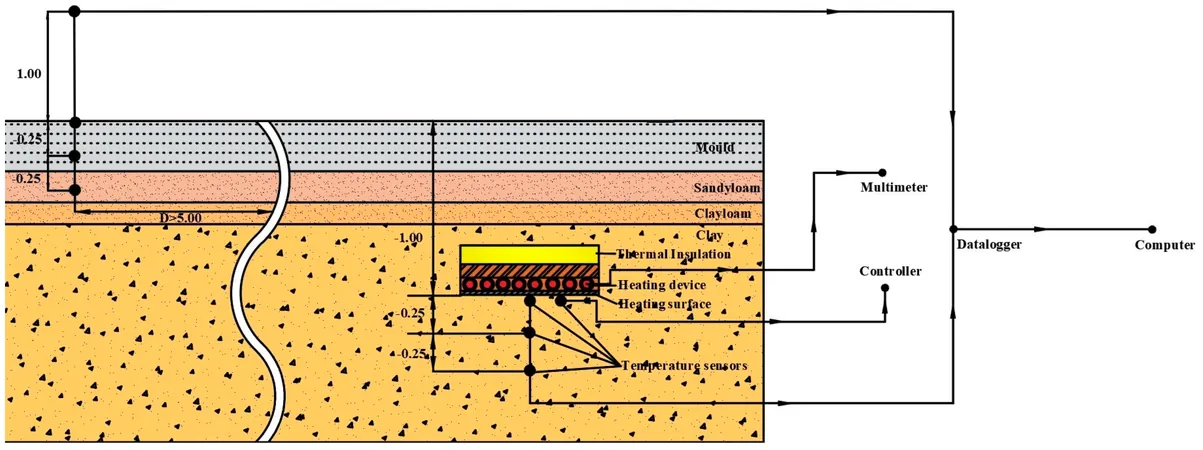
Unlocking the Earth’s Potential: Scientists Harness Soil for Thermal Energy Storage!
2025-04-02
Author: Arjun
Unlocking the Earth’s Potential: Scientists Harness Soil for Thermal Energy Storage!
As the warmth of spring signals the end of the heating season, many of us take comfort in the idea that heating needs are behind us. Yet, a team of researchers from Kaunas University of Technology (KTU) is offering an eye-opening perspective: heat isn’t just a seasonal necessity—it’s a valuable energy asset that can be harnessed and saved for future use.
Under the innovative leadership of KTU professor Dr. Tadas Ždankus, the research team is delving deep into an ingenious solution that lies beneath our feet: leveraging soil as a highly efficient thermal energy storage system! Their groundbreaking findings, published in the renowned journal Sustainability, suggest that the ground can serve as a dynamic medium for heat storage—far beyond its conventional role in construction.
Tapping into Underground Heat: A New Frontier
Initially, the KTU researchers examined the possibility of using wind energy to produce heat rather than electricity. By employing a hydraulic system instead of traditional generators, the team discovered that what were previously considered inefficiencies, known as hydraulic losses, actually produced useful heat. This prompts an exciting realization: heat that would traditionally dissipate into the ground could be converted into a practical energy source!
However, a challenge remained—much of this heat was lost before it could warm the buildings it was intended for. In an effort to tackle this issue, Dr. Ždankus and his team sought ways to efficiently store and retain this valuable heat underground for when it is most needed.
Their experiments involved artificial heat sources placed in the upper layers of the soil, where they meticulously measured heat dispersion, migration rates, and how long the thermal energy could be effectively stored. Astonishingly, they found that when the soil was heated to a specific point, moisture began to evaporate, undergoing a phase change from liquid to vapor—a crucial moment for effective heat storage.
Harnessing the Power of Phase Change
“The phase change phenomenon is pivotal for energy storage. It allows for significantly larger amounts of energy to be stored in the soil,” says Prof. Ždankus. The vapor generated travels through the ground, dissipating heat over a broader area. This ability to control the energy flow means that the system has the potential to support district heating networks or relieve pressure from power grids during overload situations.
In addition, the idea isn’t limited to large-scale systems; individual thermal accumulators could be installed under residential buildings, streets, or parking lots. With advancements in this technology, the prospect of effectively balancing energy demands is inching closer to reality!
From Theory to Practice: Entering Real-World Applications
With successful experiments confirming the viability of underground thermal storage, the KTU team shifted focus to practical applications. They investigated whether soil beneath buildings could passively collect heat, taking advantage of the natural downward flow of warmth from structures into the earth.
Dr. Ždankus shares insights into the testing process: “We developed a prototype ground energy cell alongside a setup to study heat spread through various soil depths.” Their extensive year-long measurements not only provided data on soil temperature patterns and trends but also revealed that even passive heat management could dramatically enhance energy efficiency and reduce emissions of carbon dioxide.
Collaborating for a Sustainable Future
To make these innovative soil-based energy systems accessible for widespread use, the team is diligently working on developing scaled-down prototypes and refining heat distribution systems. Collaboration is key; the project is benefiting from partnerships with specialists across different fields, including geotechnical engineering and energy systems.
As the project progresses, researchers aim to integrate technologies like boreholes and other underground heat exchange methods into a comprehensive energy storage solution that caters to both industrial and residential sectors.
The future of energy storage might just be rooted in our own backyards! If the vision of harnessing the earth itself as a thermal energy reservoir materializes, it could revolutionize how we approach heating needs and contribute to a more sustainable, energy-efficient world. Keeping an eye on these developments could surely be the key to unlocking our energy crisis. Keep following this journey—the best is yet to come!



 Brasil (PT)
Brasil (PT)
 Canada (EN)
Canada (EN)
 Chile (ES)
Chile (ES)
 Česko (CS)
Česko (CS)
 대한민국 (KO)
대한민국 (KO)
 España (ES)
España (ES)
 France (FR)
France (FR)
 Hong Kong (EN)
Hong Kong (EN)
 Italia (IT)
Italia (IT)
 日本 (JA)
日本 (JA)
 Magyarország (HU)
Magyarország (HU)
 Norge (NO)
Norge (NO)
 Polska (PL)
Polska (PL)
 Schweiz (DE)
Schweiz (DE)
 Singapore (EN)
Singapore (EN)
 Sverige (SV)
Sverige (SV)
 Suomi (FI)
Suomi (FI)
 Türkiye (TR)
Türkiye (TR)
 الإمارات العربية المتحدة (AR)
الإمارات العربية المتحدة (AR)